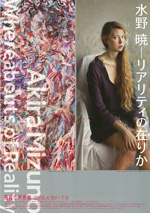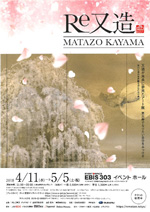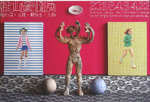 |
Picks is a monthly sampling of Japan's art scene, offering commentary by a variety of reviewers about exhibitions at museums and galleries in recent weeks, with an emphasis on contemporary art by young artists. |
 |
 |
|
|
 |
 |
|
| Akira Mizuno: Whereabouts of Reality |
| 15 April - 1 July 2018 |
Takasaki City Art Museum
(Gunma) |
 |
| Realism is in fashion these days, but Mizuno stands out from the crowd of technical adepts in the genre. When he paints a mountain, for example, he may spend several years painting it over and over, incorporating all the changes in the landscape that transpire between visits. The portraits here are all the more astonishing because Mizuno has gone a step further, recording every movement of his models. In taking realism to an extreme, he has begun to transcend it.
|
|
|
 |
|
Photography by Okamoto Taro: For the sake of thought
|
28 April - 1 July 2018 |
Taro Okamoto Museum of Art
(Kanagawa) |
 |
| Best known as an avant-garde painter and sculptor, Okamoto was also a fine photographer. The layout of this exhibition does much to bring his camera skills into sharp relief. Of the four sections on tools, streetscapes, boundaries, and people, it is the third that most successfully spotlights the technical and intellectual processes by which Okamoto, a superb anthropologist as well, moved so fluidly between the spiritual and material worlds. |
|

|
 |
 |
|
|
|
 |
 |
| Matazo Kayama: Re Matazo |
| 11 April - 5 May 2018 |
Event Space EBiS 303
(Tokyo) |
 |
| Though ostensibly an introduction to Nihonga painter Kayama (1927-2004), this exhibition seemed bent on defying expectations. Of 32 works on display, only 11 were actual paintings -- the rest were prints, ceramic tiles, videos and whatnot. Considering that finished paintings are meant to stand alone on their own terms, it seems excessive, even insulting to the artist, to surround them with all these other paraphernalia. But like it or not, that’s the exhibition format of the future. While this show may have stirred up mixed feelings, it was undeniably entertaining. |
|
|
|
|
 |
 |
 |
| The 150th Anniversary of His Birth: Yokoyama Taikan |
| 13 April - 27 May 2018 |
The National Museum of Modern Art, Tokyo
(Tokyo) |
 |
| Revered as an icon of Japanese art in the modern era, Yokoyama (1868-1958) embodied the maverick camp of the Nihonga genre through the Meiji, Taisho, and early Showa periods. What this show reveals is the surprisingly eclectic breadth of his subjects, ranging from a painting of Halley’s Comet on one of its once-every-76-years visits, to pairs of six-panel gold-leaf folding screens depicting Niagara Falls and the Great Wall of China. Perhaps Yokoyama was not so much global in his outlook as indiscriminating in his tastes, but that may be an essential quality for an artist.
|
|
|
|
|
|
|
 |
 |
| Ken Matsuyama: Paintings, Patterns, Pottery, Portraits |
| 6 - 22 April 2018 |
The Artcomplex Center of Tokyo
(Tokyo) |
 |
| This gathering of more than 200 of Matsuyama’s works included many exhibited for the first time. His motifs range from young girls and insects to candle flames, Jomon pottery, planets, and paint itself -- every work guaranteed to tickle or irritate the artistic palate. What captures one’s personal fancy is not necessarily what one would deem artistically praiseworthy, and Matsuyama knows how to exploit that gap, even force us to focus on it. Therein lies his charm.
|
|
 |
|
|
|
 |
|
|